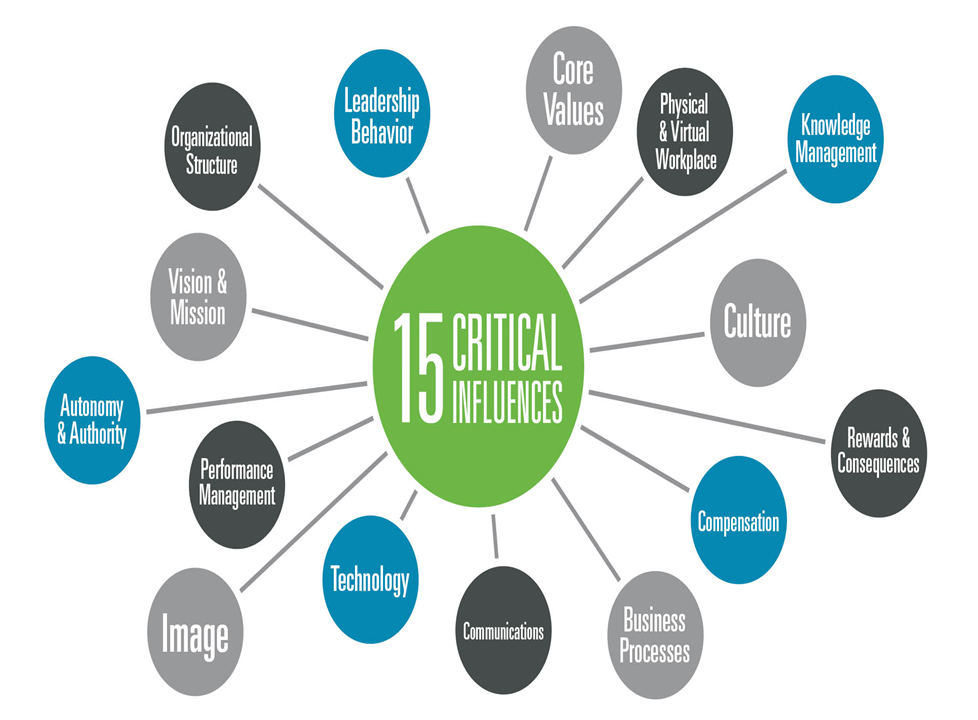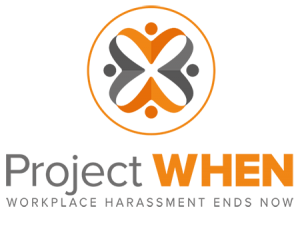15 Critical Influences™— a key result of Stegmeier Consulting Group’s decades of research
Why companies fail when introducing a new workplace
 Many enterprises’ efforts in implementing workplace change initiatives have produced less than optimal results, or have failed altogether, due to factors that business leaders may not know are linked.
Many enterprises’ efforts in implementing workplace change initiatives have produced less than optimal results, or have failed altogether, due to factors that business leaders may not know are linked.
Driven by the desire to help organizations better manage change, Stegmeier Consulting Group endeavored to fill the gaps and identify the missing pieces that obstruct or cause initiatives to fail.
A key result of SCG’s research spanning over 20 years was the discovery of 15 interdependent tangible and intangible factors — Critical Influences™ — that impact behavior in the workplace, enable or hinder the success of the workplace strategy and, ultimately, the achievement of overall corporate goals. The results of the study demonstrate the universal impact these 15 factors have on behavior in the workplace, regardless of the type of business or the size of the organization.
The output of our research on resistance to change in the workplace is shared below, as well as in our book, Innovations in Office Design: The Critical Influence Approach to Effective Work Environments™, which has been named the #1 workplace strategy book by Amazon readers.
The 15 Critical Influences™ uncovered
Undeniably, the physical workplace is regarded as the panacea for all corporate ills. Many rely on it to solve issues that turn out to be deep-rooted problems that need a significantly different approach.
When seeking to change the way work gets done at your organization, be sure to look at the big picture; most workplace strategists will focus exclusively on the physical work environment and how that change will affect your workforce.
Stegmeier Consulting Group encourages organizations to take a more holistic approach to workplace change and examine 14 other key factors. These Critical Influences™, if left unchecked, can derail a workplace initiative no matter how great the design is.

In a series of comprehensive posts, we share an elaborate presentation of our key findings on the 15 Critical Influences™ from our decades of research. Below you will find a positive (+) and negative (-) example of each of these essential factors for leading workplace change. Click on any of the links below to explore each of the Critical Influences™ in more detail and learn how they affect change in the workplace.
Vision and Mission
(+) A company “walks the talk” when it comes to its vision and mission statements guiding leadership on how to treat employees and customers in given situations.
(-) An organizational vision that emphasizes “long-term trusting relationships with its customers,” yet does not trust employees to adopt on-campus mobility, is not practicing what it preaches.
Core Values
(+) A company’s core values can serve as a theme for unity in order to kick off and follow through with a change initiative.
(-) Too often core values are left on the shelf to collect dust, and components of a workplace change initiative do not reflect the original fundamentals a company was founded upon.
Organizational Image
(+) When used properly, a modern, collaborative work environment creates a positive image in the eyes of customers and serves as an important tool for attracting and retaining talent.
(-) Outdated office designs and layouts send a message that the company is archaic and uninspiring.
Corporate Culture
(+) A goal of many new workplace strategies is to reshape the organization’s culture to one that is more collaborative, transparent, and innovative.
(-) When there is a disconnect between what an organization claims to be and what it is perceived to be, a culture of mistrust can contribute to low employee morale.
Organizational Structure
(+) The new workplace strategy is appropriately aligned with the ever-changing organizational hierarchy by incorporating flexibility to reconfigure departmental space through fewer hard walls.
(-) A new workplace strategy that maintains outdated standards of using space to reward status may invest in many under-utilized private offices.
Leadership Behavior
(+) Workplace changes have a much higher rate of success when top leaders are engaged in the initiative and hold individuals throughout the enterprise accountable for the appropriate use of the new work environment.
(-) Negativity and resistance can cascade down through an organization when leadership does little more than sign off on the new workplace strategy while carrying on as if they are exempt from the changes expected of the balance of the workforce.
Autonomy and Authority
(+) Employees feel empowered to work in a variety of settings in a shared space environment, utilizing the new work space as they see fit to be productive.
(-) Even the greatest workplace design will fail if employees are not given the autonomy and authority to select the most appropriate work setting for the task being conducted.
Compensation
(+) An organization enhances its compensation program to encourage and reward teamwork in a more collaborative work environment.
(-) Concerned with their personal income, individuals shy away from collaboration out of fear someone else may be compensated for their work and ideas.
Rewards and Consequences
(+) Rewards and consequences are used in the correct manner, such as rewarding an employee for embracing a new work space, and providing consequences for those who do not comply with new workplace protocols.
(-) Misguided consequences (such as playful reprimanding of an employee “taking a break” in a focus room) inject confusion into the work environment and discourage full utilization of the new office layout.
Performance Management
(+) In top performing organizations, managers are held accountable for their employees’ success in transitioning to new ways of working.
(-) Not seeing employees at their assigned workstations 100% of the time is not an excuse for managers to delay or forgo performance reviews. With on-campus mobility and greater flexibility in where work happens, managers should consider touching base with employees even more frequently.
Communications
(+) Proper communication is timely, properly reinforced, and is connected holistically to other organizational changes.
(-) Far too often communications regarding change focus on what employees will be losing in the new workplace, coming across as an apology.
Knowledge Management
(+) Companies develop an easily accessible, elaborate database of knowledge.
(-) Information cannot be easily accessed unless employees are in the office or on-campus, and technology hinders flexibility.
Technology
(+) Employees are provided with the devices, software, and connectivity needed to stay productive no matter where they work.
(-) Outdated technology or limited connectivity binds employees to their work area when they could be equally productive across the building, campus, or world!
Business Processes
(+) Many workplace solutions are developed to support changing business processes such as a switch to team settings instead of a linear, assembly-line style of work.
(-) Resistance arises when employees fear the new process and prefer to maintain the “old” way of doing things because of their comfort with the status quo.
Physical and Virtual Workplace
(+) By encouraging employees to choose from a variety of on-campus work settings, appropriate for the task at hand, organizations can increase the amount of time their workers are focusing on their tasks all while maximizing their real estate investment.
(-) Manager resistance to on-campus mobility, due to a lack of trust in employees, deprives an organization of the opportunity to take advantage of the above-mentioned benefits.
Applying the Critical Influence Approach™ to workplace change in your organization
Using the Critical Influence Approach™ early in the planning or even in the midst of implementing your organization’s workplace strategy, SCG can take a broad look at your enterprise and assess what issues may be barriers to effectively implementing your chosen strategy.
This strategic approach deviates from superficially patching cracks in your workplace. We understand that a significant workplace strategy often necessitates a deep dive into the intricacies of your organization’s unique system to uncover challenges that need attention.
What’s the buzz from the business community?
“The Critical Influence Approach™ to solving the problem of conflicting objectives (reducing costs and enhancing performance in the workplace) is compelling. It resonates at the core of our business objectives.”
– Seminar attendee
“The concept of the 15 Critical Influences™ is very powerful and comprehensive, and seeks to bring a 360 approach to understanding the work environment—one that speaks the language of senior management. It can help us have more in-depth dialogue with our executives when it comes to making workplace decisions that will impact the workforce.”
– Think Tank participant
“Stegmeier Consulting Group’s research reveals 15 Critical Influences™ that can make or break workplace strategies. Most futurists do not provide practical applications to incorporate today—Stegmeier is the exception to the rule!”
– Amazon reader
“My guess is that this book will be a bestseller in the design community and hopefully, its principal theme, the 15 Critical Influences™, will be adopted as standard for use by all designers.”
– Amazon reader
“The 15 Critical Influences™ ought to be studied by every business professional.”
– Amazon reader
Let’s get started!
Implementing a new workplace strategy can feel daunting, especially if you’re struggling to understand why leaders are pushing back on the thought of a new office design. Ready to take a thoughtful approach to workplace change? Get in touch with us!



